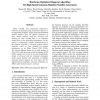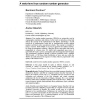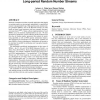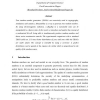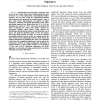119
click to vote
ERSA
2009
14 years 5 months ago
2009
Many scientific and engineering applications, which are increasingly being ported from software to reconfigurable platforms, require Gaussian-distributed random numbers. Thus, the...
IJCCBS
2010
14 years 5 months ago
2010
: True random number generators (TRNGs) are extensively used in cryptography, simulations and statistics. In this work, we introduce, extend and analyse the concept of the randomis...
ICVGIP
2008
14 years 8 months ago
2008
As vision algorithms mature with increasing inspiration from the learning community, statistically independent pseudo random number generation (PRNG) becomes increasingly importan...
109
click to vote
FPGA
2008
ACM
14 years 8 months ago
2008
ACM
Stochastic simulations and other scientific applications that depend on random numbers are increasingly implemented in a parallelized manner in programmable logic. High-quality ps...
100
click to vote
MMB
2010
Springer
14 years 9 months ago
2010
Springer
Phase-type (PH) distributions are proven to be very powerful tools in modelling and analysis of a wide range of phenomena in computer systems. The use of these distributions in sim...
106
click to vote
FPGA
2004
ACM
14 years 11 months ago
2004
ACM
Field Programmable Gate Arrays (FPGAs) are an increasingly popular choice of platform for the implementation of cryptographic systems. Until recently, designers using FPGAs had le...
116
click to vote
CHES
2005
Springer
15 years 25 days ago
2005
Springer
Abstract. In this paper, the evaluation of random bit generators for security applications is discussed and the concept of stateless generator is introduced. It is shown how, for t...
104
click to vote
FSE
2007
Springer
15 years 1 months ago
2007
Springer
Algorithmic post-processing is used to overcome statistical deficiencies of physical random number generators. We show that the quasigroup based approach for post-processing rando...
DEPCOS
2008
IEEE
15 years 1 months ago
2008
IEEE
True random number generators (TRNGs) are extensively used in cryptography, simulations and statistics. Metastability is a way to generate true random numbers. By using electromag...
116
click to vote
CEC
2008
IEEE
15 years 1 months ago
2008
IEEE
— Quasirandom or low discrepancy sequences, such as the Van der Corput, Sobol, Faure, Halton (named after their inventors) etc. are less random than a pseudorandom number sequenc...
